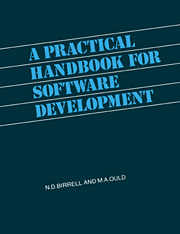Book contents
- Frontmatter
- Contents
- Foreword
- Preface
- 1 The choices facing the system developer
- 2 The software development process
- 3 Development techniques
- 4 Project Inception
- 5 System Definition
- 6 System Design
- 7 System Production
- 8 System Acceptance and Post-Acceptance Development
- 9 Project Debriefing
- Other bibliographies
- References
- Index
1 - The choices facing the system developer
Published online by Cambridge University Press: 11 January 2010
- Frontmatter
- Contents
- Foreword
- Preface
- 1 The choices facing the system developer
- 2 The software development process
- 3 Development techniques
- 4 Project Inception
- 5 System Definition
- 6 System Design
- 7 System Production
- 8 System Acceptance and Post-Acceptance Development
- 9 Project Debriefing
- Other bibliographies
- References
- Index
Summary
Given the task of developing a software system, how does one go about it? To start the building of a system of a thousand or maybe a million delivered lines of source code is a daunting (if exciting) prospect. No one should begin without a very clear idea about how the development is to be undertaken and how the quality of its output is to be assessed.
Turning this around we can say that anyone undertaking software development, on no matter what scale, must be strongly advised to establish a methodology for that development – one or more techniques that, by careful integration and control, will bring order and direction to the production process.
To paraphrase Freeman 1982: every software development organisation already has some methodology for building software systems. However, while some software is developed according to modern practices of software development, most of it is still built in an ad hoc way. So it is best to talk about software development techniques and methodologies in terms of changing current practices, replacing them with new techniques that improve the process of software development and the quality of the resulting products.
There is of course a dilemma here for us as system developers: technique X may offer us potential gains such as reduced development time, reduced costs, increased reliability, quality etc, but in adopting it we also incur the risks arising from the fact that we may be unfamiliar with technique X, it might not be suitable for the system we have to develop, and it might not suit our staff and their skills.
Information
- Type
- Chapter
- Information
- A Practical Handbook for Software Development , pp. 1 - 2Publisher: Cambridge University PressPrint publication year: 1985
